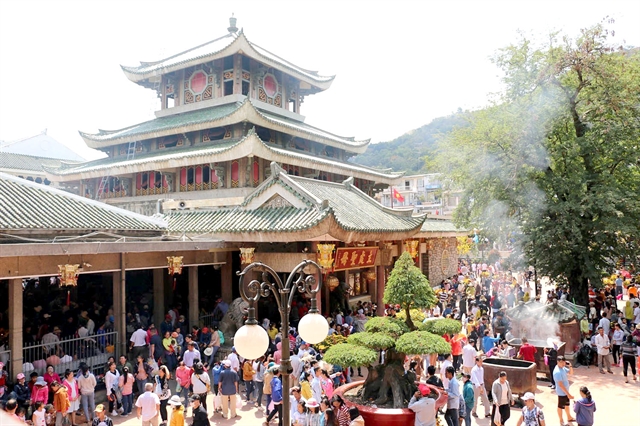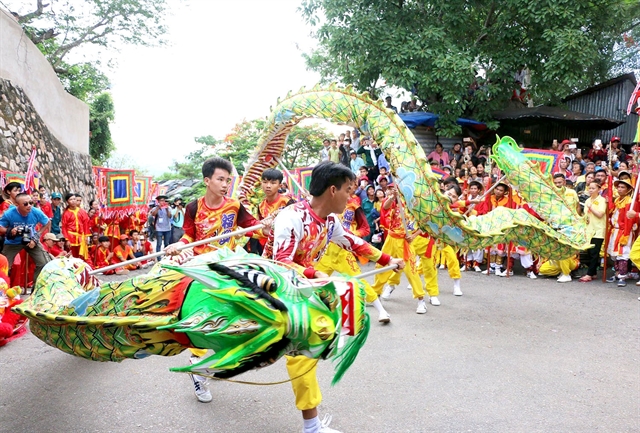 Features
Features

Authorities are preparing documents for the Bà chúa xứ Festival in Châu Đốc to be recognised as an intangible cultural heritage by UNESCO.

|
| ANNUAL AFFAIR: Every year pilgrims make the long trip to the Lady of the Realm Temple at the foot of Sam Mountain in An Giang Province. VNA/VNS Photos Công Mạo |
The cultural authority of the southern province of An Giang is preparing documents for the Bà Chúa Xứ (The Lady of the Realm) Festival in Châu Đốc to be recognised as an intangible cultural heritage by the UN cultural agency UNESCO.
Bà Chúa Xứ is a goddess protecting locals who live in the southern region. Shrines that worship her can be found in many places, including Sam Mountain in An Giang Province, Gò Tháp in Đồng Tháp Province, and HCM City, particularly in District 9 and Nhà Bè District.
Bà Chúa Xứ Festival is one of the biggest religious events in the South, attracting nearly two million pilgrims yearly.
In the southern culture, Bà Chúa Xứ represents an image of a protector of the Vietnamese border and a tutelary of prosperity and health, and has many names, including Chúa Xứ Thánh Mẫu (Holly Mother of the Realm).
In addition to communal houses across villages, the Lady of the Realm is worshipped in small shrines and even in Buddhist temples, usually represented by glass paintings, and wooden or cement statues.
The Bà Chúa Xứ Festival in Châu Đốc’s Sam Mountain is held from the 23rd to the 27th day of the fourth lunar month, with the main rituals on the 25th.

|
| JUST FOR FUN: After a solemn ceremony, folk dances, including a dragon dance, entertain the cheering crowds at the festival. VNA/VNS Photos Công Mạo |
However, pilgrims can visit Châu Đốc as early as January to experience the complex of historical and cultural relics such as the ancient pagoda of Tây Anh, Hang Pagoda, Bạc Vân Hill, Đá Chẹt Hill, Tao Ngộ Garden, and the Thoại Ngọc Hầu Mausoleum, which is home to the protector of the southwestern border under the Nguyễn Dynasty.
Bà Chúa Xứ Temple was recognised as a national monument in 1980.
The design and scale of the temple was relatively small when it was first built in Châu Đốc in the early 19th century. After many years of upgrade, it is now one of the biggest temples in Việt Nam.
Multiple solemn rites are organised on festive days, including the washing of the statue of the Lady, Túc yết rite, Xây chầu rite, and Chánh tế rite, which are carried out in that order.
The first ritual takes place at midnight on the 24th day, attracting many participants.
Two big candles in front of the Holly Mother's statue are lit and this is followed by the rites of offering incense, wine and tea for her while praying. After that, women chosen prior to the event will perform a bathing ritual for the statue with fragrant water infused with jasmine and cinnamon behind a curtain. This activity lasts for about an hour.
Túc yết, being the main rite, begins at midnight on the 25th and continues into the early morning of the 26th.
The Xây chầu rite will be held afterwards with prayers for good weather and wealthy life.
The Chánh tế rite is similar to the Túc yết rite, marking the end of the festival.
The worship of the Lady of the Realm contains different cultural layers, making it difficult to trace back the origin or background of the Lady, experts have said.
Some notable influences on the worship can be seen in folk culture, Buddhism and Taoism, among other beliefs.
Pilgrims who flock to the festival tend to pray for fortune, health and peace in life.
The Bà Chúa Xứ Festival was recognised as a National Intangible Heritage in 2014.
In addition to traditional ceremonies, locals can enjoy numerous activities such as folk performances and kylin-dragon dances during the festival period. VNS




